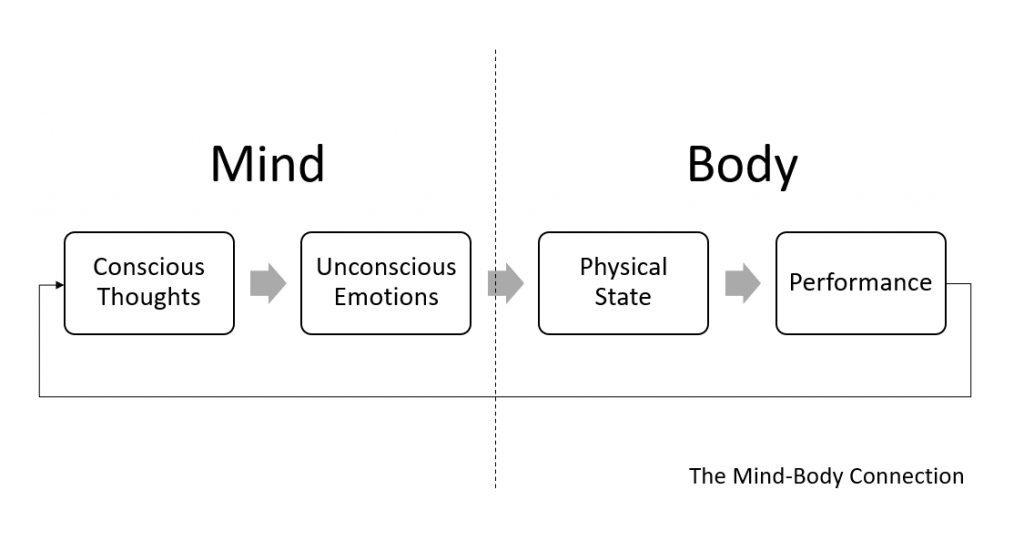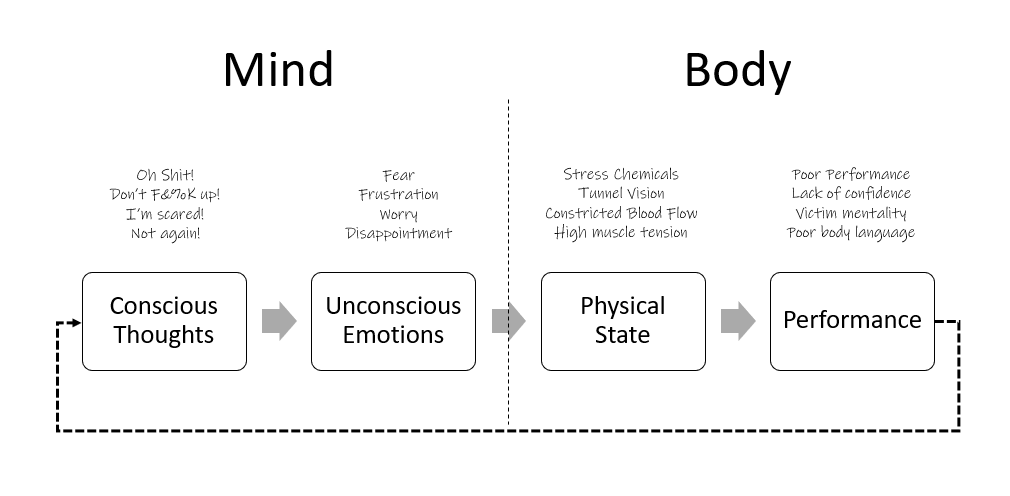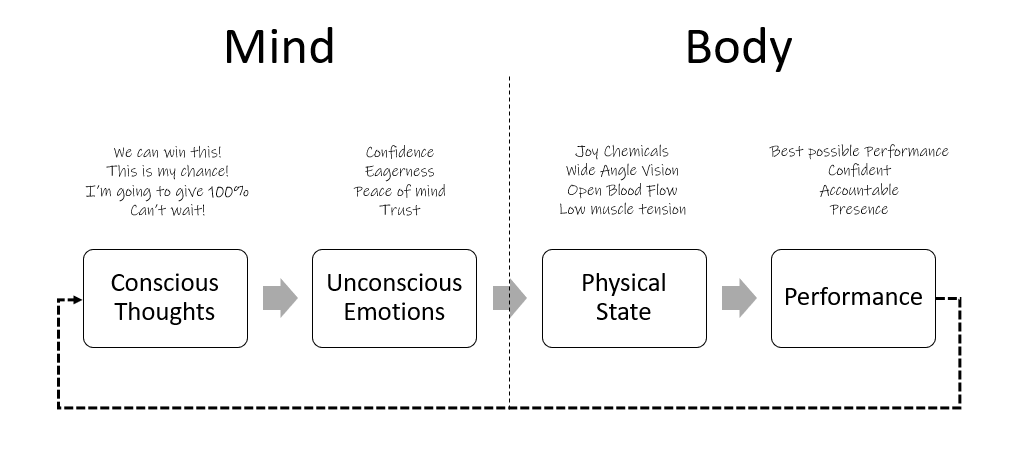Back in the days…
Pre internet and even pre-ATARI.
The mind and body were considered distinct and separate entities.
Almost as if our lives were divided into two.
The mind, our thoughts and emotions were the domain of the mystics, poets and witchcraft.
While our body subscribed to the laws of chemistry, biology and physics.
Back in the good old days, common consensus was that the mind-body connection didn’t exist.
What you thought about or even remembered had no relevance in the physical domain.
The body didn’t really care what the mind was up to and most believed it didn’t impact our performance or even our lives.
Once Upon a Time
In the early eighties, Atari captivated the world whilst hypnotising the youth.
Meanwhile, below all the hype…
Another movement was about to boil over.
Eastern philosophies started to gain popularity through Yoga and meditation.
Crazy things started to happen…
Parents started to report feelings of calmness, relaxation and wait for it, happiness. Was it the ATARI or was it the Eastern philosophies causing the change?
People started to improve performance and their levels of confidence.
A New Hypothesis
With all the hype and attention created by the East, Harvard & Stanford decided to investigate what was going on?
Could meditation affect bodily processes like blood pressure, oxygen consumption and heart rate?
Could the mind be connected to your body?
Could you improve performance and your confidence just by thinking about it?
Early indications suggested that the mind was in fact, connected to the body. In spite of early correlations and hundreds of scientific papers proving that the mind could affect one’s physical state, the results were not widely accepted by the majority.
“When subjects changed how they thought and cultivated a peaceful, serene emotional state, their bodies did indeed respond with dramatic reductions in these processes”- from the classic 1975 bestseller The Relaxation Response- Herbert Benson.
Back to the Future
With modern technologies, decades of research and the emergence of various case studies, the old belief that the mind and body are not connected has met the same fate as the Atari console.
If we were to summarise today’s mind-body connection it would be.
“Your conscious thoughts have a huge influence on your performance by the way they shape your mood and in turn affect your physical state.

Not only that…
Each mood, physical state and performance becomes the subject of further internal scrutiny.
The result?
A continuous…
Twenty-four/ seven…
…three hundred- and sixty-five-day year process where your thoughts influence your feelings, which in turn influence your physical state, which in turn influences your performance, which is then thought about again in a self-sustaining perpetual cycle.
The Mind-Body Connection
Unless you’ve been living under a rock, there’s a connection.
With everything going on in the world, you must never forget that we are embodied human beings.
This connection is constantly working in the background. It either enhances or degrades your life and the associated performance. There is no binary outcome, neutral or middle ground.
Let’s discuss and illustrate what happens to a young player that is struggling with the inner critic.
Player A is a physical beast on the field with incredible speed and agility. He is able to outrun and outmaneuver most players with ease. He also possesses great strength and endurance, making him a force to be reckoned with in the midfield.
Despite his impressive physical attributes, Player A lacks soccer confidence. He often second-guesses himself and struggles to take control of the game. He also tends to shy away from one-on-one battles, preferring to pass the ball instead of taking a shot on goal.
He spends most of his time sitting on the bench, being negative and trying to avoid making mistakes. His internal chatter is reflected in Fig 1.1 The Sewer Cycle

The Sewer Cycle
Player A is experiencing the “Sewer Cycle”.
You know what goes down the sewer system?
Although Player A resembles that of a Greek God, his performance suffers because of the following sequence.
He’s afraid to make a mistake and continues to doubt his playing ability. (Thought pattern)
This leads to disappointment, frustrations and ultimately fear. (Emotions)
His emotional state then leads to the body responding by restricting blood flow, creating tension in the muscles and a tidal wave of stress chemicals in the body. (Physical state)
This ultimately results in a lack of confidence and poor performance. Player A looks defeated before the game even begins and becomes lost, trying to shy away from the ball. (Performance)
The Success Cycle
Player B is a fierce competitor with a relentless fighting spirit. He may be small in stature, but he has the heart of a lion and always gives 100% effort on the field. He is determined to win and has a strong sense of teamwork and camaraderie with his teammates. His mental chatter is reflected in Fig 1.2 The Success Cycle.
His emotional state is driven by a flood of constructive thoughts which produces a different physical response and state.
Player B thinks the following when given a chance to play.
“This is my chance!” “Let’s give 100%” “Lets help the team.”
Instead of feeling tense and afraid, Player B feels energised, inspired and believes in his playing ability. As a consequence, the body releases pain-reducing chemicals in the brain and reduces muscle tension and opens up the blood flow to the body.

A Big Disclaimer
Sounds easy on paper, doesn’t it?
But here comes the big warning label.
Even the most confident soccer players switch between the two cycles.
You’ve all seen that gifted player miss a penalty and suddenly never step up to take another one. The last-minute own goal that got your team relegated could also switch your thoughts to the sewer cycle.
What matters is the following…
How often and how frequently are you in the success cycle or the sewer cycle?
Are you playing the game swimming in the sewer or are you giving yourself every opportunity to succeed?
What thoughts are you contemplating during match day?
Are you ready to fight, kick and scream to win or are you afraid to make a mistake?
Before you unpack the old Atari console and relive the glory days, being aware of your thoughts and changing them does not guarantee success or that you’ll win the game.
The mind-body connection helps you maximise your chances of winning and tasting success. It puts you in the best possible state to perform by creating a warrior attitude of energetic curiosity.
You do this by thinking and changing your perspective…
…and as a by-product, you’ll receive a big burst of soccer confidence.
Deliberate Thinking
Before your next game, try this on for size…
Choose to think you’re the best soccer player on the pitch.
Choose to think that you’re going to give 100% irrespective of what happens on the green pastures.
Choose to become an asset to the team and ensure you treat yourself with self-care.
As parents…
Coaches.
…and caring human beings, it is our duty to ensure the thought patterns circulating in our children’s minds are constructive.
…giving them every chance to succeed.
At the end of the day, which player do you think has the greatest chance of succeeding?
Player A or Player B?
“May the winds of destiny blow you to the stars.”




Leave a Reply